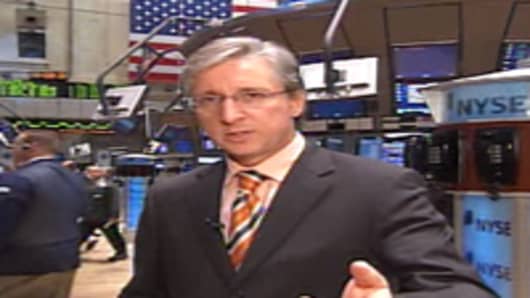That's what we saw late in the day today--forced liquidation. There were many strange declines in stocks that clearly were indicative of forced liquidation: Continental Airlines down 17% (!), Standard Pacific down 12%, Aluminum Corp of China down 9%, Freeport McMoran down 7%, Alexander & Baldwin down 7%, Intercontinental Exchange down 6%, U.S. Steel down 6%.
There is NOTHING in the fundamental outlook that would support these declines.
You can see this forced liquidation as the yen carry trade unwound further today.
In fact, many carry trades have been unraveling recently. A carry trade simply involves borrowing an asset at one interest rate, selling the asset, then invests those funds into a different asset that generates a higher interest rate or return. The most famous example is the yen carry trade, but there are others.
Quant funds have had a different kind of carry trade--go long small cap value (pay higher dividend, better balance sheet) and go short growth stocks. Surprise! Suddenly small cap values have notably underperformed, against the model's expectations, and quant funds have gotten smacked hard.
There are carry trades with debt as well. One of the most simple has been to go long senior debt of strong balance sheet companies, and short growth equities and subordinated debt of lesser balance sheet companies. Surprise! Debt of even strong balance sheet companies with triple-A ratings has been under attack; this is also against the model's expectations.
What does all this mean? It means the world is not quite as creative as everyone thought. It means there are a lot of crowded trades out there in very similar strategies, and everyone is trying to get out at same time.
Someone, somewhere, is going to make an epic amount of money on these dislocations. Right now, this takes nerves of steel.
Important Points
(posted earlier today)
What's happening?
I get asked that question a lot these days, and somehow just muttering "credit market issues" doesn't do it. So here's a stab at trying to explain what is happening.
Most important points:
1) Banks and brokers are raising cash to cover their commitments. What kind of commitments? Leveraged buyout bridge loan commitments, mortgage warehouse lines, all sorts of commitments.
2) At the same time, the banks and brokers are de-levering their clients (hedge funds, commodity traders, etc.)--asking for more cash. The yen has been strengthening recently--at a five month high--and for many this is a sign that their clients are raising cash.
3) Some bank clients appear to be responding to the bank and brokerage demand for more money by redeeming money market shares. This is probably why we are seeing such a flutter in this sector.
4) The implication: higher cash levels mean lower profits for banks and brokers.
This, in addition to any write-downs for losses they may have to take.
The result is that the financials are dropping and becoming a smaller part of the S&P 500. Five months ago, the S&P Financial Sector was 21.5% of the S&P, today it has dropped to 19.8%.
However, historically the financial sector has contributed more in terms of earnings to the S&P 500--about 25%, according to Standard and Poors. A 30% haircut in earnings--which seems extreme, but is what some bears are arguing may happen--means S&P earnings could drop 8% just from financials.
That is why we are not seeing much of a bounce in financials. The argument that stocks are cheap on valuation is not working for the moment because of lack of visibility. However, if, as bulls argue, these banks are out ahead of the problem and losses will be relatively minor compared to historical profits, then financials may prove to be one of the great buys of the year.
Bearish Mood Grows
(posted earlier today)
Unusual amount of bearish opinion is apparent on the street this
morning. In-line Consumer Price Index, always an important indicator, did little to move the markets.
Certainly the technicals are not great. Lowry's, in a note to clients, said yesterday that the Dow was the only major index still above its 200 day moving average (an important support level). Some excerpts:
- "Yesterday did not appear to be the sort of day when the market was in the process of putting in a sustainable bottom."
- "Over the past few days, these indicators were unable to rise only a very short distance above oversold readings before turning lower again--usually the mark of a weak rally."
Another veteran trader on the floor was also bearish. He said: "We have securitized all these products, we don't know what is in all these derivative products that were packaged, and many of the products appear to have been mis-rated."
Keep an eye on metal stocks--weaker than the overall market recently. The Yen is at a five month high against the dollar, as the carry trade may be quietly unwinding--again. Many investors borrowed cheap money in yen and invested all over Asia, including real estate and equities--especially commodities. Emerging markets index at a two month low. Dollar rallying elsewhere.
Not all bad news. Merrill Lynch, in its latest survey of global fund managers, said "the pull-back in equity markets has left stocks more attractively valued, especially relative to bonds."
Traders telling me that the bond market is pricing in a 100% chance the Fed cuts rates 0.25% at the Sept 18th meeting and an 18% chance they cut by 0.5%. Tony Crescenszi from Miller Tabak said, "By pricing with such confidence the chances of a rate cut, the markets are essentially forcing the Fed's hand. The Fed can follow the markets, a preferred approach when the economy has experienced inflation pressures."



